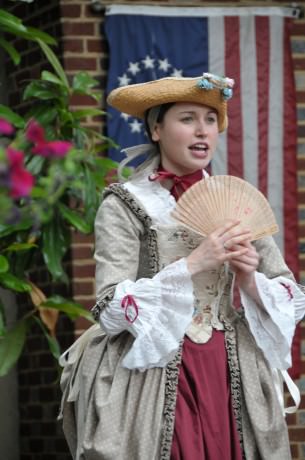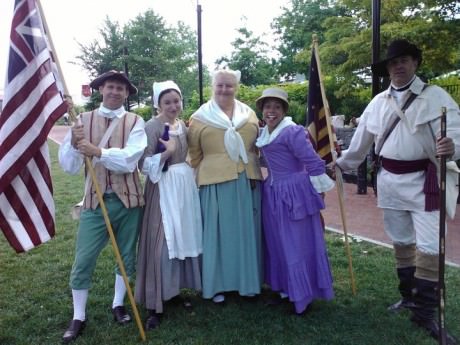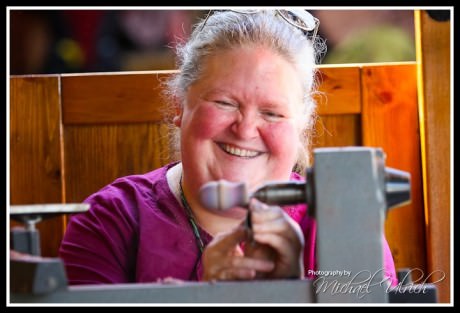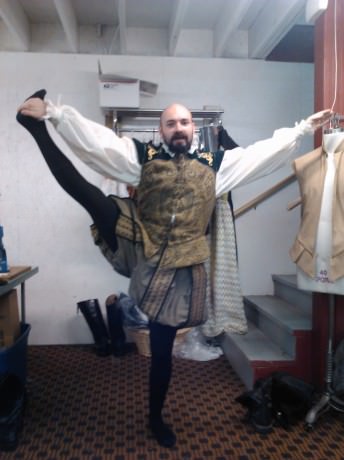Not long ago, my aunt observed me knitting away and asked where I had learned the skill. “Well, when you work in other centuries, you just pick things up,” I replied.
She laughed, but it’s true. When spending so much time “in other centuries,” as I describe it, it is difficult not to learn new (or, rather, “old”) skills. What follows is a list of skills that Johnny and I have learned over our years toiling in other time zones and being “married to the stage.”
Things Natalie Can Do Now
• Knitting: Honestly, I don’t understand different stitches and have no idea how to “pearl.” However, I do know how to knit a basic scarf. Sometimes, I’ll make the pattern narrow and call it a belt. I also know a neat pattern that produces a “twirling” scarf thanks to my friend Keith Henley. (Seriously. It’s awesome). I’ve used this skill during my time working for both Historic Philadelphia, Inc. and Macy’s Dickens Village in Philadelphia. My wooden needles are appropriate to pull out if I am watching a longer show during Johnny’s seasons at the PA Renaissance Faire. It’s also a fantastic way to relax (or feel productive while watching TV.) This skill took me a long time and lots of practice to master, especially since my learning occurred on the cobblestoned walks of Old City Philadelphia, often in front of crowds of tourists. My friend Gini Loomis taught me. During my first lesson, a tourist asked what we were doing. When Loomis replied that she was teaching me to knit, as I, in my upper-class snobbery, had forgotten, the tourist replied, “Well, she’s not doing a very good job!” Loomis quickly explained, “Madame, she has been at it ten minutes!” Despite my embarrassment, I finally learned how to knit a basic scarf. For uncoordinated me, this is a big deal.
• Tying Corsets, or, rather, “Stays”: This is something that I do not miss from working in other centuries. Tying corsets- or, for the 18th-century term, “stays,”- is not for the faint-hearted. Fortunately, mine tied in the back, so friends would often help. (One of my directors, Doug Thomas, made me the “hero of the day” at work once when I was able to fully costume myself one morning. Yup, dressing oneself in an upper-class female’s outfit from centuries ago without assistance is that big a deal. Let’s not talk about attempting to use the “privy” in such a costume).

• Jam-making: As I have mentioned in a previous post here, Johnny and I made massive quantities of fig jam when we lived outside of Philadelphia. My mother’s fig tree, whom we have affectionately dubbed “Figgy, Jr.” is a hearty tree that produces upwards of 1,000 figs annually. Fig jam made fantastic gifts, and preserving fruits and vegetables is a practical skill to have if one ever plans on having a garden.
• Filing Powder Horns: During my first summer as a “first-person interpreter,” I did not actually play a “real-life” historical figure. Instead, I created a character called Molly McConnell, an Irish indentured servant, basically in the genre of historical fiction. My friend and co-worker, Fred, is a blind artisan who crafts gunpowder horns from bull horns. The powder horns are incredibly smooth and shiny, but the male bovines don’t exactly grow them that way. They start incredibly rough and have to be filed down. Fred and I decided that Miss McConnell would apprentice to him in an effort to learn a skill for when her indenturement was finished. A woman wouldn’t necessarily have apprenticed in this way, but I needed something to do on Harmony Lane during slow days and was often there with Fred, so we decided that it worked for us. I enjoyed that time immensely, though this was quite possibly the smelliest craft I have ever done. (My husband has similar observations about the very “memorable” odor from turning horn and antler on a lathe).

Things Natalie Never Really Learned
• Quilling: Quilling is, as I describe it, “the art of paper-rolling.” The paper is rolled into many different shapes pasted together to make a picture. When done well, it results in absolutely beautiful, intricate artwork. The best I could do was create basic letters and shapes with mine. I did enjoy describing what colonial glue could have been made of, however. Most tourists assumed that I was crafting with a paste made from flour and water. In order to list the ingredients of other “colonial” glues, my excuse, valid or not, was that flour and water made far to lumpy a paste for such a delicate craft. “Oh, no, I much prefer glue made from horses; I think they boil the horses’ hooves.… Does not Mr. Elmer do the same in your day?” Edu-tainment, folks. That’s where it’s at.
• Embroidery: Okay, so this is a skill that I never really tried. Technically-speaking, it would have been worth picking up, but, at my place of employment, I had a great deal of quality, handspun wool yarn readily available. Additionally, as mentioned above, I am not exactly a coordinated person (more like a clumsy puppy who hasn’t grown into its paws yet.) Knitting was a major accomplishment. The more technical art of embroidery felt way too complex, especially to learn while entertaining tourists.
Johnny’s “Historic” Skills
• Sword fighting*: Johnny did not learn these skills while working “in other centuries” while at the Ren Faire these past three seasons, but working with historical weaponry has become one of his most noteworthy skills. (When my husband says that he is “polishing his sword,” he is quite literally polishing his sword, no dirty euphemisms here.) I am not even sure how many stage-worthy swords and other weapons we have accumulated over the years. Johnny has most of those at the Ren Faire; I only have need of one, the court sword Johnny gifted me with for my 21st birthday, that I keep next to my bed when my husband isn’t there. (I realize that stage-worthy swords aren’t necessarily good for cuts, but, still, used improperly, they can cause some decent bruises and other damage. While I hope that this never happens, should an intruder arrive, I just hope that facing them with a sword in hand will make me look a lot tougher. A broad sword would probably be better, but I make do with what I have.) These are skills that Johnny picked up while working and studying as an actor beginning in Montreal under fight director Jean-Francois Gagnon, where, among other things, he did a stage combat demonstration for the Prince of Persia video game years ago. He has also taught movement and stage combat at the university level. Here is one of my favorite fights of his, during the 2011 faire season, with then-fight partner, Sam Little. Johnny played Francesco di Medici, Grand Duke of Tuscany, and Little played Sir Robert Dudley, one of Queen Elizabeth I’s favorite courtiers.
• Jam-Making: Yup, Johnny helped me with this! And it is a lot of work, especially when you are harvesting the fruit yourself. Often, I stood in the hot summer kitchen that the modern air conditioning couldn’t even penetrate, boiling pots of the fruit on the stove. Johnny would gather dozens of figs from the tree outside. Fig trees, for those not familiar, are not exactly user-friendly, either. The leaves are incredibly rough, basically nature’s version of sandpaper, and will often leave skin itchy afterwards. Additionally, the fruit emits sap that, while not as sticky as glue, is a decent substitute and does not wash away easily. Add to that the fact that hornets love to burrow into and eat ripe figs, and you’ve potentially got a recipe for disaster (pun intended). We are lucky enough to not have injuries while harvesting figs, and our jam recipes were major successes.
• Lathe Work: Again, as I’ve mentioned in a previous post here, we have had the fantastic fortune of befriending Scott and Kathy Griffith of Dragon’s Eye Creations and Craig Baratz of Sir Launch-a-Lot. The Griffiths make handmade pens, key chains, styluses, bottle stoppers, and more. Baratz makes marshmallow catapults. Johnny has been able to work with Scott especially and learn how to do lathe work himself and produced most of the Christmas gifts we gave out last year. More on the Dragon’s Eye Creations and Sir Launch-a-lot in an upcoming article.

• Rocking a Pair of Pumpkin Pants While Doing the Splits: Actually, no learning required here; baby, he was born this way. Need I say more?

*Fight video courtesy of Alyssa Foley and Sam Little.




